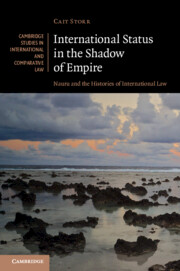Book contents
- International Status in the Shadow of Empire
- Cambridge Studies in International and Comparative Law: 150
- International Status in the Shadow of Empire
- Copyright page
- Contents
- Illustrations
- Acknowledgements
- Prologue
- 1 International Status, Imperial Form: Nauru and the Histories of International Law
- 2 From Trading Post to Protectorate, 1888
- 3 From Protectorate to Colony to Mandate, 1920
- 4 From Mandate to Trust Territory, 1947
- 5 From Trust Territory to Sovereign State, 1968
- 6 After Independence: Sovereign Status and the Republic of Nauru
- Bibliography
- Index
- Cambridge Studies in International and Comparative Law
3 - From Protectorate to Colony to Mandate, 1920
Published online by Cambridge University Press: 20 August 2020
- International Status in the Shadow of Empire
- Cambridge Studies in International and Comparative Law: 150
- International Status in the Shadow of Empire
- Copyright page
- Contents
- Illustrations
- Acknowledgements
- Prologue
- 1 International Status, Imperial Form: Nauru and the Histories of International Law
- 2 From Trading Post to Protectorate, 1888
- 3 From Protectorate to Colony to Mandate, 1920
- 4 From Mandate to Trust Territory, 1947
- 5 From Trust Territory to Sovereign State, 1968
- 6 After Independence: Sovereign Status and the Republic of Nauru
- Bibliography
- Index
- Cambridge Studies in International and Comparative Law
Summary
Chapter 3 traces the accretion of imperial administration in Nauru from 1888 to 1920. The formal status of Nauru shifted twice, from protectorate to colony to British mandate. From 1888, Nauru was administered as part of the German Marshall Islands, and later subsumed under the direct colonial control of German New Guinea in 1906. The Jaluit Gesellschaft sold its phosphate rights to the British-owned Pacific Phosphate Company, which developed a mining operation under German administration. In 1914 Nauru was occupied by Australia on British request. The chapter retraces the advent of the League of Nations mandate system, arguing that C Mandate status marked an uneasy compromise between advocates of internationalised administration of the occupied territories and the annexationist Dominions of Australia and South Africa. As Nauru’s legal status shifted from protectorate to C Mandate, administrative control was assumed by Australia pursuant to an intra-imperial bargain between Britain, Australia and New Zealand, which established a tripartite phosphate monopoly. The chapter concludes that the basic division of public and private authority established in 1888 survived this shift.
Keywords
- Type
- Chapter
- Information
- International Status in the Shadow of EmpireNauru and the Histories of International Law, pp. 100 - 160Publisher: Cambridge University PressPrint publication year: 2020

